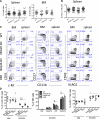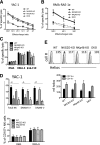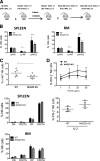Characterization of a novel NKG2D and NKp46 double-mutant mouse reveals subtle variations in the NK cell repertoire
- PMID: 23649470
- PMCID: PMC3689249
- DOI: 10.1182/blood-2012-12-471607
Characterization of a novel NKG2D and NKp46 double-mutant mouse reveals subtle variations in the NK cell repertoire
Abstract
The immunoreceptors NKG2D and NKp46 are known for their capacity to activate natural killer (NK) cell cytotoxicity and secretory responses in the contexts of tumors and infections, yet their roles in NK cell education remain unclear. Here, we provide the first characterization of mice deficient for both NKG2D and NKp46 receptors to address the relevance of their concomitant absence during NK cell development and function. Our findings reveal that NK cells develop normally in double-mutant (DKO) mice. Mice lacking NKG2D but not NKp46 showed subtle differences in the percentages of NK cells expressing inhibitory Ly49 receptors and the adhesion molecule DNAM-1. A slightly increased percentage of terminally differentiated NK cells and functional response to in vitro stimuli was observed in some experiments. These alterations were modest and did not affect NK cell function in vivo in response to mouse cytomegalovirus infection. NKp46 deficiency alone, or in combination with NKG2D deficiency, had no effect on frequency or function of NK cells.
Figures








Similar articles
-
Modulation of NKG2D, NKp46, and Ly49C/I facilitates natural killer cell-mediated control of lung cancer.Proc Natl Acad Sci U S A. 2018 Nov 13;115(46):11808-11813. doi: 10.1073/pnas.1804931115. Epub 2018 Oct 31. Proc Natl Acad Sci U S A. 2018. PMID: 30381460 Free PMC article.
-
NK cell receptor NKG2D sets activation threshold for the NCR1 receptor early in NK cell development.Nat Immunol. 2018 Oct;19(10):1083-1092. doi: 10.1038/s41590-018-0209-9. Epub 2018 Sep 17. Nat Immunol. 2018. PMID: 30224819 Free PMC article.
-
NKp46 and DNAM-1 NK-cell receptors drive the response to human cytomegalovirus-infected myeloid dendritic cells overcoming viral immune evasion strategies.Blood. 2011 Jan 20;117(3):848-56. doi: 10.1182/blood-2010-08-301374. Epub 2010 Oct 28. Blood. 2011. PMID: 21030563
-
Lessons from NK Cell Deficiencies in the Mouse.Curr Top Microbiol Immunol. 2016;395:173-90. doi: 10.1007/82_2015_473. Curr Top Microbiol Immunol. 2016. PMID: 26385768 Review.
-
Physiologic functions of activating natural killer (NK) complex-encoded receptors on NK cells.Immunol Rev. 2001 Jun;181:126-37. doi: 10.1034/j.1600-065x.2001.1810110.x. Immunol Rev. 2001. PMID: 11513134 Review.
Cited by
-
Largely preserved functionality after the combined loss of NKG2D, NCR1 and CD16 demonstrates the remarkable plasticity of NK cell responsiveness.Front Immunol. 2023 Jul 13;14:1191884. doi: 10.3389/fimmu.2023.1191884. eCollection 2023. Front Immunol. 2023. PMID: 37520575 Free PMC article.
-
Antitumor immunity. A shed NKG2D ligand that promotes natural killer cell activation and tumor rejection.Science. 2015 Apr 3;348(6230):136-9. doi: 10.1126/science.1258867. Epub 2015 Mar 5. Science. 2015. PMID: 25745066 Free PMC article.
-
Endothelial cells express NKG2D ligands and desensitize antitumor NK responses.Elife. 2017 Dec 12;6:e30881. doi: 10.7554/eLife.30881. Elife. 2017. PMID: 29231815 Free PMC article.
-
Natural killer cell NKG2D and granzyme B are critical for allergic pulmonary inflammation.J Allergy Clin Immunol. 2014 Mar;133(3):827-35.e3. doi: 10.1016/j.jaci.2013.09.048. Epub 2013 Nov 28. J Allergy Clin Immunol. 2014. PMID: 24290277 Free PMC article.
-
Group 1 innate lymphoid-cell-derived interferon-γ maintains anti-viral vigilance in the mucosal epithelium.Immunity. 2021 Feb 9;54(2):276-290.e5. doi: 10.1016/j.immuni.2020.12.004. Epub 2021 Jan 11. Immunity. 2021. PMID: 33434494 Free PMC article.
References
-
- Biassoni R, Cantoni C, Pende D, et al. Human natural killer cell receptors and co-receptors. Immunol Rev. 2001;181:203–214. - PubMed
-
- Lanier LL. NK cell recognition. Annu Rev Immunol. 2005;23:225–274. - PubMed
-
- Kim S, Iizuka K, Kang HS, et al. In vivo developmental stages in murine natural killer cell maturation. Nat Immunol. 2002;3(6):523–528. - PubMed
-
- Carotta S, Pang SH, Nutt SL, Belz GT. Identification of the earliest NK-cell precursor in the mouse BM. Blood. 2011;117(20):5449–5452. - PubMed
Publication types
MeSH terms
Substances
Grants and funding
LinkOut - more resources
Full Text Sources
Other Literature Sources
Molecular Biology Databases
Research Materials

